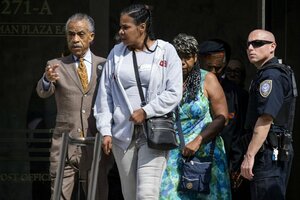How the Rev. Al Sharpton became today's most influential civil rights leader
Twenty years ago, the Rev. Al Sharpton was the flamboyant counterpoint to more staid civil rights leaders. He’s still controversial. But today, Rev. Sharpton is the main voice of those protesting police treatment of black men.

Rev. Al Sharpton (L) and Esaw Garner (2nd-L), wife of Eric Garner, who died after being put in a chokehold by a New York City police officer, exit after meeting with U.S. Attorney Loretta Lynch in the Brooklyn borough of New York, August 21, 2014.
Brendan McDermid/REUTERS
New York
To both the surprise and chagrin of many, the Rev. Al Sharpton, organizer of the major protest march and rally to be held in New York City Saturday, has been emerging as the most prominent civil rights leader of the Obama era, if not the past ten years.
Twenty years ago, this might have seemed unthinkable. Though still a controversial and even polarizing figure today, in decades past Rev. Sharpton was the flamboyant counterpoint to more staid civil rights leaders such as Jesse Jackson and Andrew Young, and taken far less seriously by establishment elites.
Back then, Sharpton was the portly, gold medallion-wearing, charismatic sidekick to the godfather of soul James Brown – both sported long, wavy, slicked-back looks. And those outside the fiery preacher’s circles saw him more as a race-baiting agitator and media-seeking charlatan who would lead any racial protest, regardless of its merit or advisability.
Today, however, a slimmed-down and toned-down Sharpton has surpassed most of his peers as the face of the early 21st-century civil rights movement. He is the major spokesman for those protesting the police killings of Eric Garner in New York and Michael Brown in Ferguson, Mo., serving, too, as the go-to community liaison on race matters for both President Obama and Mayor Bill de Blasio.
“I’ve known Al since he was 12 years old, and he’s arrived at the level he always wanted to arrive at, which is gratifying,” the Rev. Jesse Jackson, also involved in Ferguson, told Politico this week. “He’s the man who’s the liaison to the White House, he’s the one who’s talking to the Justice Department.”
Even former President George W. Bush had kind words for the polarizing figure at the end of his final term, saying at an education event in 2009 that he had found “common ground” with Sharpton.
“See, he cares just as much as I care about making sure every child learns to read, write, and add and subtract,” Mr. Bush said. “And I want to thank you for your leadership on this issue, and I appreciate you.” Sharpton uses the quote in his own promotional materials these days.
But the still-charismatic leader, who has left his medallions and track suits behind, hosting now a popular syndicated radio show as well as the cable talk show “PoliticsNation” on MSNBC, continues to rankle those who remember his controversial past.
In the 1980s, Sharpton on a number of occasions led thousands of mostly black protesters into white neighborhoods, places where mobs of whites had beaten and killed black men in a series of high profile racial crimes.
The killing of 16-year-old Yusef Hawkins in Bensonhurst, Brooklyn, by a gang of mostly Italian American youth, sparked dozens of Sharpton-led protests through white neighborhoods – which many believe only inflamed tensions and made matters worse. During one of these, a local resident stabbed and seriously wounded the then-flamboyant protest leader.
In 1991, Sharpton led similar marches in the aftermath of the Crown Heights riots, which took place after a Jewish driver struck and killed a seven-year old black boy. For four days, mostly black residents rioted, looted, and clashed with Jewish residents in the mixed neighborhood, which led to the murder of Yankel Rosenbaum, a Jewish student from Australia.
And perhaps most infamously, Sharpton stood by a 15-year-old black girl, Tawana Brawley, who said six white men had raped and degraded her. She and Sharpton even accused a Dutchess County prosecutor of being one of the perpetrators. A grand jury concluded that there was “overwhelming evidence” that the young Ms. Brawley fabricated her story, and Sharpton reached one of the lowest points in his career when a jury concluded he had defamed the prosecutor, ordering him and others to pay almost $350,000 in civil damages.
So many now can only seethe as Sharpton has become the statesman at the side of the nation’s most powerful politicians. In July, members of the NYPD were outraged when Mayor de Blasio called what was to be a healing moment in a roundtable of police officials, social activists, and clergy. De Blasio sat with Police Commissioner Bill Bratton to his right and Sharpton to his left.
But Sharpton, unaware he would be sharing the stage with Commissioner Bratton, took the opportunity to criticize the tactics of the NYPD, which he said afflict black communities and led directly to the death of Mr. Garner.
“What gives Sharpton the right to be at the table?” said Sgt. Ed Mullins, a 30 year veteran of the force and president of the Sergeant's Benevolent Association, saying that Sharpton was not a “credible individual,” and “just a person who’s disrupted the city.”
But on Saturday, as Sharpton prepares to lead thousands in protest of the police killings of two black men this summer – a march and rally that could be the largest and most significant of his career – and then to give the eulogy at Mr. Brown’s funeral on Monday, the respect being accorded the controversial minister has changed dramatically.
“Whether you like Al Sharpton or not, he clearly is a spokesperson, particularly for African-Americans, and that is reality,” Bratton told the Associated Press in August.

